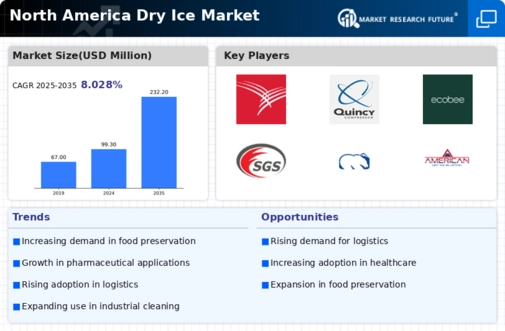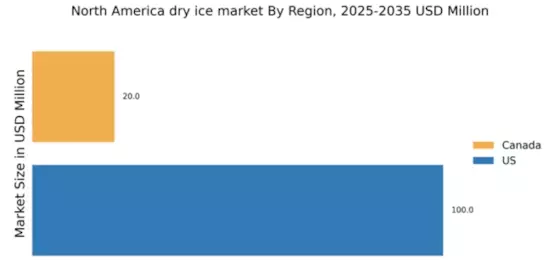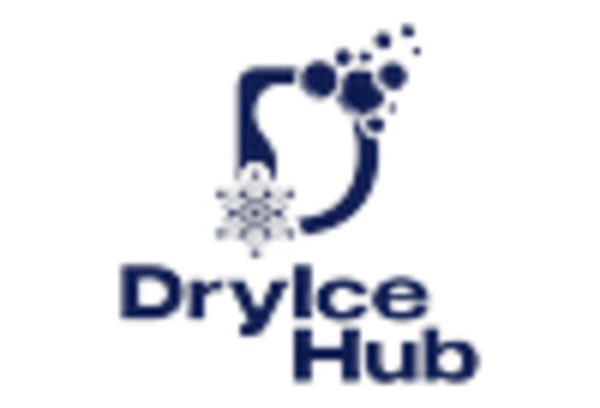Growth in E-commerce Logistics
The surge in e-commerce logistics is a pivotal driver for the dry ice market in North America. As online shopping continues to gain traction, the need for effective shipping solutions has become paramount. Dry ice serves as an efficient refrigerant, ensuring that perishable goods maintain their quality during transit. In 2025, the e-commerce sector is projected to reach approximately $1 trillion in sales in North America, which could lead to an increased demand for dry ice. This growth is likely to be fueled by the rising consumer preference for home delivery services, necessitating reliable temperature control solutions. Consequently, logistics companies are increasingly incorporating dry ice into their shipping protocols, thereby bolstering the dry ice market. The interplay between e-commerce growth and the need for temperature-sensitive shipping solutions appears to be a significant factor driving market expansion.
Expansion of Cold Chain Infrastructure
The expansion of cold chain infrastructure is a significant driver for the dry ice market in North America. As the demand for temperature-sensitive products increases, the need for robust cold chain logistics has become essential. Dry ice is integral to maintaining the required temperatures throughout the supply chain, particularly for perishable goods and pharmaceuticals. In 2025, the cold chain logistics market is projected to reach $25 billion in North America, indicating a growing investment in temperature-controlled storage and transportation solutions. This expansion is likely to enhance the efficiency of supply chains, thereby increasing the reliance on dry ice for effective temperature management. The development of advanced cold chain systems appears to create a favorable environment for the dry ice market, as businesses seek to optimize their logistics operations.
Increased Focus on Food Safety Standards
The increased focus on food safety standards is a notable driver for the dry ice market in North America. As consumers become more health-conscious, regulatory bodies are implementing stricter guidelines for food preservation and transportation. Dry ice plays a vital role in maintaining the integrity of perishable food items, ensuring they remain safe for consumption. In 2025, the food safety market is expected to grow by 10%, driven by heightened awareness and compliance with safety regulations. This growth is likely to result in a higher demand for dry ice as food manufacturers and distributors seek reliable methods to meet these standards. The emphasis on food safety not only enhances consumer trust but also stimulates the dry ice market, as businesses invest in effective preservation techniques to comply with regulations.
Rising Demand in Pharmaceutical Shipping
The rising demand for pharmaceutical shipping is a crucial driver for the dry ice market in North America. As the pharmaceutical sector continues to expand, the need for reliable temperature-controlled shipping solutions has become increasingly important. Dry ice is essential for transporting temperature-sensitive medications and vaccines, ensuring their efficacy during transit. In 2025, the pharmaceutical logistics market is projected to reach $100 billion in North America, with a significant portion relying on dry ice for safe delivery. This trend is further supported by regulatory requirements for maintaining specific temperature ranges during transportation. Consequently, pharmaceutical companies are increasingly turning to dry ice as a preferred shipping method, thereby propelling the growth of the dry ice market. The intersection of pharmaceutical demand and stringent shipping regulations appears to create a robust market opportunity.
Technological Advancements in Production
Technological advancements in the production of dry ice are influencing the dry ice market in North America. Innovations in manufacturing processes have led to increased efficiency and reduced costs, making dry ice more accessible to various sectors. For instance, the introduction of automated systems in dry ice production facilities has enhanced output rates, allowing manufacturers to meet the growing demand. In 2025, the production capacity of dry ice in North America is expected to increase by approximately 15%, driven by these technological improvements. Furthermore, advancements in storage and transportation technologies are enabling better preservation of dry ice, thus expanding its applications across industries. As production methods evolve, the dry ice market is likely to benefit from enhanced supply chain dynamics, ultimately supporting its growth trajectory.


















Leave a Comment